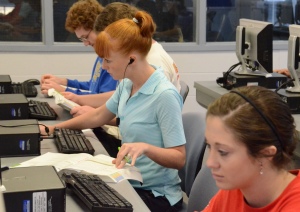Hangout Demonstration for Fall Faculty Inservice
Jefferson Davis Community College
Objectives:
After completing this lesson, you should be able to:
- Define Google Hangouts
- Explain what you need to conduct a hangout
- Discuss four basic educational benefits of Google Hangouts
- Identify the differences among Skype, Facetime, and Google Hangouts
- Explain how to plan a Google Hangout for a classroom project, demonstration, or discussion
- Explain how to start a Google Hangout
- Discuss security concerns related to students
- Examine ways of overcoming fear of using new technology
What is a Hangout?
Google provides free video conferencing called a “hangout.” Up to 9 students can join the instructor in a hangout (total of 10 people in hangout).
Google provides the capabilities for educators to create a virtual space where they can share PowerPoint presentations, YouTube videos, charts, graphs, and other documents. Students can collaborate on group projects and share documents.
Hangouts provide the instructor with multiple ways to accommodate the varied learning styles of students. Hangouts offer a means of extending the classroom beyond the classroom walls. Hangouts are also a wonderful opportunity to invite experts from around the world to connect with your students.
What do students need to participate in a hangout?
You don’t need much to conduct a hangout. All you need is a computer with high speed internet and a web camera and microphone. Web cams are priced anywhere from $10 to about $80. The inexpensive web cams will work fine for classroom purposes.
4 basic educational benefits of hangouts
- Students can collaborate on class projects. As you know, many community college students have jobs and families. They do not have a lot of extra time to be hanging around campus to work on group projects. Google hangouts provide an inexpensive and effective means for students to work together on projects.
- Online classes can be enhanced through the use of hangouts. Students in online classes can feel isolated. Students sometimes feel like they miss out on classroom discussions. Hangouts can simulate a classroom discussion. If you teach the equivalent class on campus, you could invite the online students to join the discussion with your on campus students through a hangout.
- While no more than 10 students can join the hangout at a time, you can choose the option to automatically upload the hangout to YouTube. Students who did not participate in the hangout can view the hangout (but not participate).
- Google Hangouts can also be beneficial to faculty and divisions. Division meetings could be conducted over hangouts saving valuable office time and travel money. Some committee meetings would work well over a Google Hangout. Interviews could be conducted over a hangout.
What are the differences among Skype, Facetime, and Google Hangouts?
Many people have said that the quality of the video is much better with Google Hangouts. The quality of the picture, however, is dependent on the student’s internet connection.
One of the major differences for our students is that the Google Hangout is bundled with students’ Google email accounts. So the students do not need a separate account. They are required to download a PlugIn the first time they use it, but it is very easy to do.
With Facetime, the student would be required to have an Apple Device (iPad,iPhone, iPod Touch, or Mac) and Wifi. Only two can connect at a time.
How do I plan a Google Hangout for a classroom project, demonstration, or discussion?
Below are some ideas to help you plan a Google Hangout for your class. Keep in mind that the instructor does not always have to be the one to initiate the hangout. You can assign students to groups. Provide the guidelines to students and appoint one of the students to be in charge of initiating the hangout.
- Designate one student to be the host and in charge of initiating the hangout and keeping everyone on topic.
- Don’t go too long. Google does not set a time limit on hangouts. You should determine ahead of time how long the hangout should be. Don’t go over an hour.
- Start by allowing all students to introduce themselves.
- Encourage all students to participate.
- Ask students to connect to the hangout 5 or 10 minutes ahead of the start time so that they can get their computers and cameras set up; make sure sound is working properly, etc.
- Encourage students to look at the camera to make eye contact rather than looking at the other students on their screen.
- Ask students who are not speaking to mute their speakers. Background noise can be distracting.
How do I start a Google Hangout?
- Hangouts are part of Google+. So first make sure that you have a Google+ account.
- Go to the stream on your Google+ page and click on Start a Hangout on the right hand side.
If this is the first time you have used a Hangout, you will be prompted to install a plugin. Follow the onscreen instructions. Google will congratulate you when you have finished. Make sure your webcam is working properly. Webcams are very easy to set up.
3. If you use a headset with a microphone, it will improve the quality of your experience. However, it works fine without it.
4. If the hangout does not work properly, try closing out all programs, rebooting your computer, and try again.
5. Next, invite others to your hangout. Suggest that students add everyone in the class to a circle. You can invite entire circles or selected students to your hangout. To do so, type the student’s name, the name of a circle, or click one of the profile pictures of the people in your circles who are currently online.
6. The students you invite will see a post in their stream. They will also see a list of the people who are currently in the hangout.
Note: you can also start a hangout by clicking on the camera above the comment section of a post.
What are some of the security concerns with using hangouts with students?
There are always concerns with using the Internet in an educational setting. I am going to list a few concerns that I am aware of as far as students are concerned. Please feel free to add other concerns to the comment section of this blog.
- Know that even though you initiate and start the hangout, you don’t own it.
- Know that anybody can join the hangout. I have not had this problem so far. But you need to be aware that anyone could join and you would not be able to stop them.
- There is no way to kick anyone out of a hangout but you can leave a hangout when you get ready.
- You can block someone during a hangout, but it is my understanding that the person you block is not removed immediately. It takes a little time. When you block someone, you will not be able to see each other. The person you block will not be able to join another one of your hangouts, and you will not be able to join that person’s hangouts.
- If a person gets your link and wants to join, they can do so even though you did not invite them.
How do I overcome the fear of using this new technology?
One of the best ways to learn to use Google Hangout is to join other hangouts. Here are a few hangouts that I find interesting.
- Sarah Hill, Hangout Host and interactive news anchor for KOMU-TV. You might want to read her blog on How to Host a Hangout on Air (Sarah Hill)
- Google in Education
- Getting Started with Google Hangouts in Education
You may also be interested in reading:
What the Plus (Guy Kawasaki)











